|
B: See
bel. |
|
Back
Channel:
A means of communication from users to content providers. Examples
include a connection between the central office and the end user, an
Internet connection using a
modem, or systems where
content providers transmit interactive television (analog or digital) to
users while users can connect through a back channel to a web site, for
example.
|

|
|
BB-I:
Abbreviation for Broadband Interactive
Services. The delivery of all types of interactive video, data, and
voice services over a broadband communications network.
|
|
Backreflection
(BR): A term applied to any process in
the
cable plant
that causes light to change directions in a fiber and return to the
source. Occurs most often at connector interfaces where a glass-air
interface causes a reflection.
|

|
|
Backscattering:
The return of a portion of scattered light to the input end of a fiber;
the scattering of light in the direction opposite to its original
propagation.
|
|
Bandwidth
(BW): 1) The difference
between the lower and upper frequencies of a band of electromagnetic
radiation. 2)The amount of data that can be passed along a
communications channel in a given amount of time.
|
|
Bandwidth•Distance Product:
A figure of merit equal to the product of
the fiber’s length and the -3 dB bandwidth of the optical signal. The
bandwidth•distance product is usually stated in megahertz • kilometer
(MHz•km) or gigahertz•kilometer (GHz•km). It is a useful figure of merit
for predicting the effective fiber bandwidth for other lengths, and for
concatenated
fibers. |
|
Bandwidth-limited Operation:
The condition in a fiber optic link when bandwidth, rather than received
optical power, limits performance. This condition is reached when the
signal becomes distorted, principally by
dispersion,
beyond specified limits.
|
|
Baseband:
A method of communication in which a signal is transmitted at its
original frequency without being impressed on a carrier.
|
|
Baud: A unit of signaling speed equal to the
number of signal symbols per second, which may or may not be equal to
the data rate in bits per second.
|
|
Beamsplitter:
An optical device, such as a partially reflecting mirror, that splits a
beam of light into two or more beams. Used in fiber optics for
directional couplers.
|
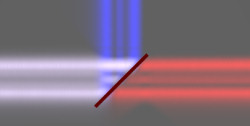
|
|
Bel
(B): The logarithm to the base 10 of a
power ratio, expressed as: B = log10(P1/P2),
where P1 and P2 are distinct powers. The
decibel,
equal to one-tenth bel, is a more commonly used unit.
|
|
Bending Loss:
Attenuation caused by high-order modes radiating from the outside of a
fiber optic
waveguide
which occur when the fiber is bent around a small radius. See also
macrobending,
microbending.
|
|
Bend Radius:
The smallest radius an optical fiber or fiber cable can bend before
excessive attenuation or breakage occurs. Bending a fiber less than the
minimum recommended bend radius will shorten it's service life and cause
excessive attenuation. Most fibers can tolerate a minimum bend radius of
2".
|
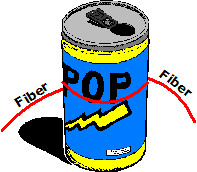
|
|
BER
(Bit Error Rate): The
fraction of
bits
transmitted that are received incorrectly. The bit error rate of a
system can be estimated as follows:
|

Where N0
= Noise power spectral density (A2/Hz).
IMIN = Minimum effective signal amplitude (Amps).
B = Bandwidth (Hz).
Q(x) = Cumulative distribution function (Gaussian
distribution).
|
|
BIDI:
Abbreviation for bidirectional
transceiver,
a device that sends information in one direction and receives
information from the opposite direction.
|
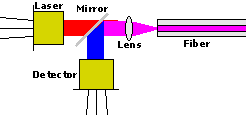
|
|
Bidirectional:
Operating in both directions. Bidirectional couplers operate the same
way regardless of the direction light passes through them. Bidirectional
transmission sends signals in both directions, sometimes through the
same fiber.
|
|
Binary:
Base two numbers with only two possible values, 0, or 1. Primarily used
by communication and computer systems.
|
|
Birefringent:
Having a
refractive index
that differs for light of different
polarizations.
Several crystalline materials such as calcite exhibit birefringence.
|

|
|
Bit:
The smallest unit of information upon which digital communications are
based; also an electrical or optical
pulse
that carries this information.
|

|
|
Bit Depth:
The number of levels that a pixel might have, such as 256 with an 8-bit
depth or 1,024 with a 10-bit depth.
|
|
BITE:
Abbreviation for built-in test equipment. Features designed into a piece
of equipment that allow on-line diagnosis of failures and operating
status. Status LEDs are one example.
|
|
Bit Period
(T): The amount of time required
to transmit a logical one or a logical zero.
|
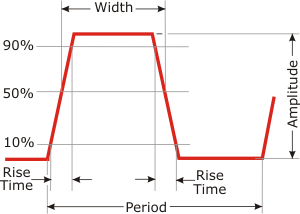 |
|
BNC:
Popular coax bayonet style connector, Often used
for baseband video.
|

|
|
Bragg Grating:
A technique for building optical filtering functions directly into a
piece of
optical fiber
based on interferometric techniques. Usually this is accomplished by
making the fiber photosensitive and exposing the fiber to deep UV
light through a grating. This forms regions of higher and lower
refractive indices in the fiber
core.
|
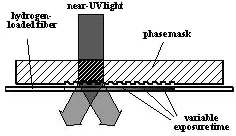
|
|
Broadband: A method of communication where the
signal is transmitted by being impressed on a high-frequency carrier.
|
|
Buffer:
1) In
optical fiber,
a protective coating applied directly to the fiber (illustrated). 2) A
routine or storage used to compensate for a difference in rate of flow
of data, or time of occurrence of events, when transferring data from
one device to another.
|
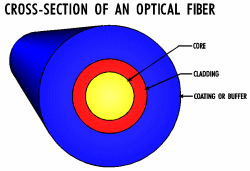
|
|
Bus Network:
A
network topology
in which all terminals are attached to a transmission medium serving as
a bus. Also called a daisy-chain configuration.
|

|
|
Butt Splice:
A joining of two fibers without optical connectors arranged end-to-end
by means of a coupling.
Fusion splicing
is an example. A mechanical splice is shown.
|

|
|
Bypass:
The ability of a node to isolate itself optically from a network while
maintaining the continuity of the
cable plant.
|

|
|
Byte:
A unit of eight
bits.
|

|